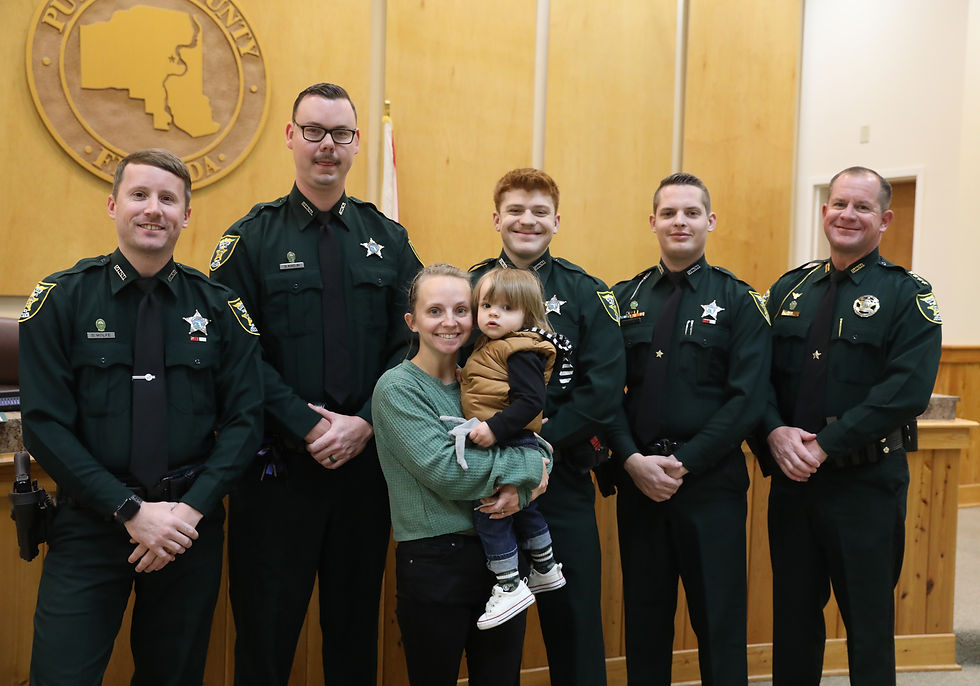SKELETAL REMAINS EXHUMED, LOOKING FOR ANSWERS IN 40 YEAR COLD CASE
- Putnam County Sheriff
- Dec 5, 2023
- 3 min read
Dec. 5, 2023
In 1981, sheriff’s office deputies were dispatched to a call of a body found in a wooded area 30 feet from Old San Mateo Road in East Palatka. The body was of a man in decomposition with no identification, nude and face down.
At the time the autopsy was limited due to decomposition and anthropological analysis was not available for skeletal remains. “John Doe” was buried in a pauper’s grave at Oak Hill Cemetery and his case went cold.
In April Forensic Investigator Madison Worley with the Medical Examiner’s office took over the unidentified cases for the office and began going through each one.
“As I was going through I found this case file set off to the side and as I was looking through it was very small and nothing really that had been done with it since the 1980s. So I contacted Capt. (Chris) Stallings and both of us kind of went on an adventure,” Worley said.
After contacting multiple labs to see if any biological material was saved, Worley contacted Stallings to inform him she did not have any DNA to do testing.
“So I asked (Stallings) what was the possibility of exhuming him to get some samples to send of for DNA and genealogy.”
In July, Sheriff H.D. “Gator” DeLoach made the formal request for funding from the Florida Sheriffs Association Cold Case Advisory Commission chaired by Citrus County Sheriff Mike Prendergast.
Their effort led to a crew of about 20 detectives, forensic specialists from the University of South Florida, medical examiner personnel and others to gather last week to an unmarked plot in the far corner of Oak Hill Cemetery where John Doe was laid to rest more than 40 years prior.
“This man was someone’s son,” DeLoach said. “Based on his approximate age, he could have been a father and a husband. He has family who never knew what happened to him and they deserve to know. He deserves to have his name restored and hopefully this is the first step. We are extremely grateful to the Florida Sheriffs Association Cold Case Advisory Commission for providing funds to help us in this mission.”
A few days earlier the ground was surveyed to denote the approximate area of John Doe’s location. Once the initial ground was broken and several feet dug, shovels were then used to locate a Ziegler box, which was used instead of a casket at the time of burial.
Using a tractor, several feet of earth was disinterred, revealing the rusted Ziegler box. Sheriff DeLoach and sheriff’s office Chaplain Karl Flagg jumped in and began using shovels to remove dirt from around the box so it could be removed from the hole.
Once the box was topside, Dr. Erin Kimmerle from the University of South Florida and her team of forensic anthropologists along with Worley, opened the box and cut away the body bag to verify there were remains inside. From there the medical examiner’s office took custody of John Doe’s skeletal remains for a wash prior to being sent to USF and the Florida Institute for Forensic Anthropology and Applied Science.
Due to the nature in which John Doe was found, the sheriff’s office is treating this case as a homicide unless information proves otherwise. In his letter to the FSA Cold Case Advisory Commission Sheriff DeLoach stated there is strong evidence to suggest this case could be re-classified to homicidal violence once Dr. Kimmerle completes a full examination. Due to the advances in DNA technology, one goal is to identify John Doe’s family and return his remains to them. Additional procedures include assessing for trauma, injuries or skeletal pathology, analyzing the remains for biological profile and imaging the facial area.
“The Commission’s previous work has proven to be pivotal in numerous cold cases across Florida,” said Citrus Sheriff Prendergast. “As Chairman of the FSA CCAC, I am proud to be able to assist PCSO in furthering the investigation of this case and bringing justice to the victim’s family.”
Testing and imaging will take months and as new developments arise, we will provide updates through social media and our website.







Comments